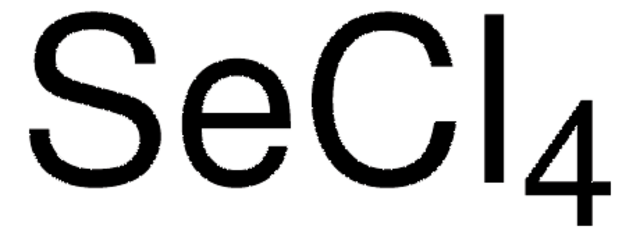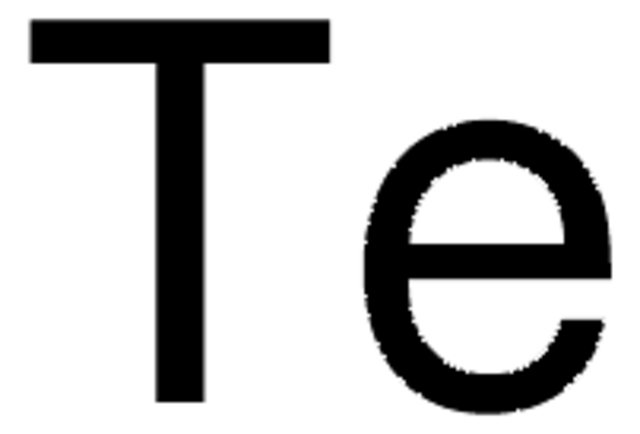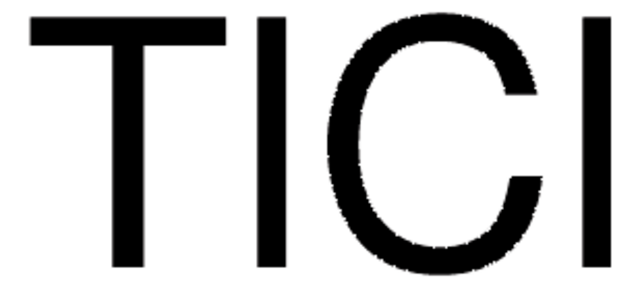추천 제품
Grade
for analytical purposes
분석
99%
양식
powder, crystals or chunks
bp
380 °C (lit.)
mp
224 °C (lit.)
density
3.26 g/mL at 25 °C (lit.)
SMILES string
Cl[Te](Cl)(Cl)Cl
InChI
1S/Cl4Te/c1-5(2,3)4
InChI key
SWLJJEFSPJCUBD-UHFFFAOYSA-N
유사한 제품을 찾으십니까? 방문 제품 비교 안내
일반 설명
Atomic number of base material: 52 Tellurium
애플리케이션
- Highly efficient regioselective synthesis of organotellurium compounds: Explores the reactions of Tellurium Tetrachloride with 1-alkenes, highlighting its utility in organic synthesis (VA Potapov et al., 2017).
- Cyclization Reactions: TeCl4 acts as a bis-electrophile in double-electrophilic cyclization reactions, demonstrating its versatility in organic transformations (N Korol, M Slivka, 2018).
- Regio-and stereoselective addition of tellurium tetrachloride: Investigates the addition of TeCl4 to methyl propargyl ether, emphasizing the stereochemistry of the addition process (MV Musalova et al., 2017).
신호어
Danger
유해 및 위험 성명서
Hazard Classifications
Skin Corr. 1B
Storage Class Code
8A - Combustible corrosive hazardous materials
WGK
WGK 3
Flash Point (°F)
Not applicable
Flash Point (°C)
Not applicable
개인 보호 장비
Eyeshields, Faceshields, Gloves, type P3 (EN 143) respirator cartridges
이미 열람한 고객
Maria V Musalova et al.
Molecules (Basel, Switzerland), 17(5), 5770-5779 (2012-05-17)
The reaction of tellurium tetrachloride with acetylene proceeds in a stereospecific anti-addition manner to afford the novel products E-2-chlorovinyltellurium trichloride and E,E-bis(2-chlorovinyl)tellurium dichloride. Reaction conditions for the selective preparation of each of these products were found. The latter was obtained
Puneet Vij et al.
Environmental toxicology and pharmacology, 34(3), 768-782 (2012-10-17)
Diphenyl ditelluride (DPDT) and tellurium tetrachloride (TeCl(4)) were evaluated for toxicity in transformed (HT-29, Caco-2) and non-transformed colon cells (CCD-18Co). Significant decreases in viability were observed with DPDT exposure in HT-29 (62.5-1000 μM), Caco-2 (31.25-1000 μM) and CCD-18Co cells (500-1000
P Mareeswari et al.
Enzyme and microbial technology, 95, 225-229 (2016-11-22)
We report an efficient method to biosynthesize biocompatible cadmium telluride and cadmium sulphide quantum dots from the fungus Rhizopus stolonifer. The suspension of the quantum dots exhibited purple and greenish-blue luminescence respectively upon UV light illumination. Photoluminescence spectroscopy, X-ray diffraction
J F Van Vleet et al.
American journal of veterinary research, 43(11), 2000-2009 (1982-11-01)
Seventy newly hatched ducklings were fed a commercial ration with 500 mg of added Te (as tetrachloride)/kg of feed for up to 28 days. Ducklings were euthanatized at day 14, 21, and 28, the hearts were studied by gross, microscopic
Shalini Roy et al.
Food and chemical toxicology : an international journal published for the British Industrial Biological Research Association, 49(10), 2564-2574 (2011-07-12)
Tellurium tetrachloride (TeCl(4)) and diphenyl ditelluride (DPDT) cytotoxicity, was investigated in rat astrocytes. Concentrations of 0.24-250μM (24h) were tested for viability using MTT(3-[4,5-dimethylthiazol-2-yl]-2,5-diphenyl tetrazolium bromide) and trypan blue exclusion. MTT showed significant decreases at all concentrations tested for both compounds.
문서
High Purity Metalorganic Precursors for CPV Device Fabrication
Colloidal quantum dots (CQDs) are semiconducting crystals of only a few nanometers (ca. 2–12 nm) coated with ligand/surfactant molecules to help prevent agglomeration.
자사의 과학자팀은 생명 과학, 재료 과학, 화학 합성, 크로마토그래피, 분석 및 기타 많은 영역을 포함한 모든 과학 분야에 경험이 있습니다..
고객지원팀으로 연락바랍니다.







